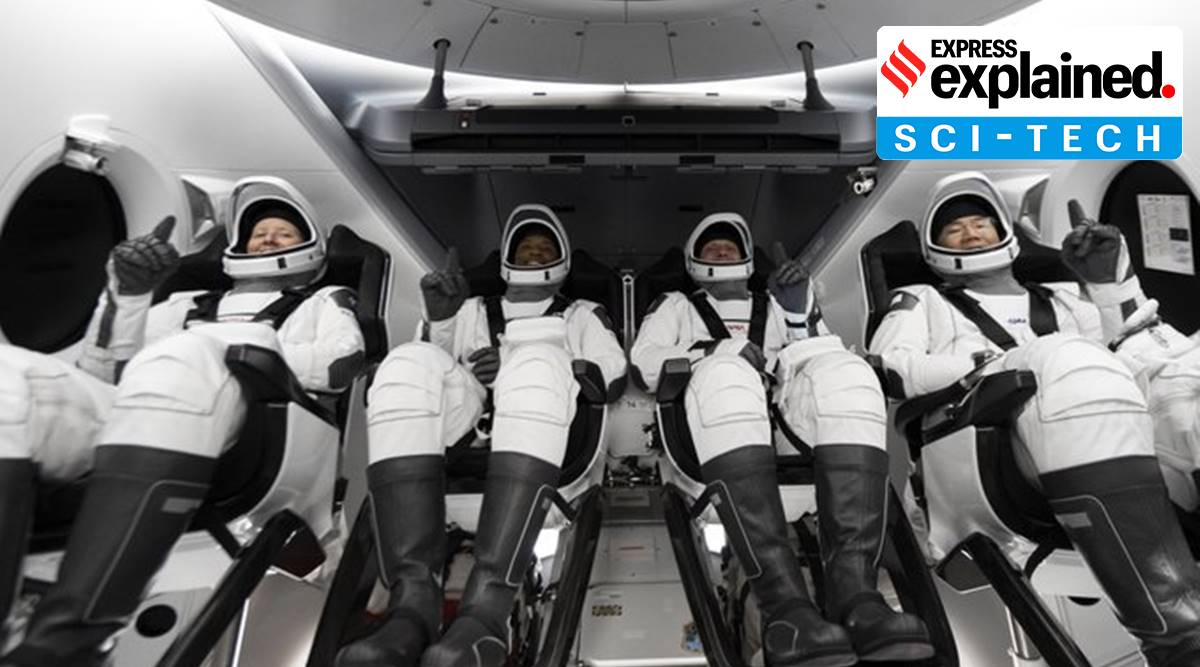
Updated: November 17, 2020 10:34:31 am
 Crew Dragon crew ready for launch. (Photo: Twitter / @ SpaceX)
Crew Dragon crew ready for launch. (Photo: Twitter / @ SpaceX)
As part of the first commercial human spacecraft system in NASA history, a crew of four astronauts is now en route to the International Space Station (ISS) on a 27-hour flight, aboard the Crew Dragon spacecraft from SpaceX called Resilience.
The mission was initially due to launch on November 14, but was hampered by unfavorable weather conditions. Crew-1 is the first operational flight of the SpaceX Crew Dragon spacecraft on a Falcon 9 rocket to the ISS and is also the first of three such flights scheduled over the course of 2020-21.
What is the Crew-1 mission?
It is the first of six manned missions that NASA and SpaceX will operate as part of the Commercial Crew Program, which aims to facilitate access to space in terms of cost, so that cargo and crew can be easily transported to and from the ISS, allowing further scientific investigation. The program is a way to reduce the cost of going into space for agencies like NASA and also makes it possible for any individual to buy a ticket on a commercial rocket. Therefore, the launch is considered the beginning of a new era in space travel.
“This partnership is changing the arc of manned spaceflight history by opening up access to low Earth orbit and the International Space Station to more people, more science, and more business opportunities,” NASA said.
Boeing and SpaceX were selected by NASA in September 2014 to develop transportation systems intended to move the US crew to the ISS. “These integrated spacecraft, rockets, and associated systems will carry up to four astronauts on NASA missions, maintaining a space station crew of seven to maximize time spent on scientific research in the orbiting laboratory,” says the website of The NASA.
In May, NASA’s SpaceX Demo-2 test flight took off for the ISS, becoming the first crewed flight to launch from US soil since the end of the space shuttle era in 2011. Last week, NASA certified SpaceX’s Crew Dragon capsule and Falcon 9 rocket, making it the first spacecraft certification provided by the space agency.
The Crew-1 mission launched agency astronauts Michael Hopkins, Victor Glover, and Shannon Walker along with Japan Aerospace Exploration Agency (JAXA) mission specialist Soichi Noguchi from Launch Complex 39A at Kennedy Space Center to a six-month mission aboard the ISS. , where they will be joined by members of Expedition 64, the space station crew that currently resides there.
Increase resilience. 🚀
The Crew-1 mission has taken off in a Falcon 9 rocket since @NASAKennedy at 7:27 p.m. ET and he’s on his way to @Spacial station. #LaunchAmerica pic.twitter.com/5Q3uXSLvqt
– NASA (@NASA) November 16, 2020
Hopkins, who is the commander of the Crew Dragon spacecraft and the Crew-1 mission is responsible for all phases of spaceflight, from launch to re-entry. Glover is the pilot of the Crew Dragon spaceship, while Walker and Noguchi are the mission specialists. 📣 Follow Express explained on Telegram
Why is the mission important?
The Crew-1 mission marks many firsts for NASA and SpaceX, including the first NASA-certified commercial system flight, the first international crew of four to launch on an American commercial spacecraft, the first time the long-duration expedition of the space station. The crew size will increase from six to seven crew members, adding to the crew time available for investigation and the first time the Federal Aviation Administration has authorized the launch of a human orbital spaceflight.
While the Crew Dragon spacecraft is capable of remaining in orbit for a period of 210 days, it will return in spring 2021, making it the longest human space mission launched from the U.S. The spacecraft will also deliver more than 500 pounds of cargo, scientific hardware, and experiments to the ISS.
Upon completion of the mission, the Crew-1 astronauts will board the Crew Dragon, which will undock and exit the space station autonomously, after which it will re-enter Earth’s atmosphere.
Also in Explained | What is the Leonid meteor shower? When can Indians see it best?
What will Crew-1 members do on the ISS?
The mission objectives are the same as those of Expedition 1 that took off 20 years ago. NASA has called these two ISS missions “historic”. On the ISS, the Crew-1 team will team up with members of Expedition 64 and conduct microgravity studies.
Some of the research the crew brings with them includes materials to investigate the physiology of food, which will study the effects of dietary improvements on immune function and the gut microbiome and how those improvements can help crews adapt to spaceflight. . Once in orbit, NASA astronaut Glover will collect samples to provide data to scientists on Earth so they can continue to study how changes in diet affect your body.
Another experiment aboard Crew Dragon is a student-designed experiment titled “Genes in Space-7” that aims to understand how spaceflight affects brain function. Other experiments include research that will allow scientists to understand physical interactions in liquids, rocks, and microorganisms, another experiment on the role of microgravity in human health, and how microgravity affects heart tissue.
© IE Online Media Services Pvt Ltd
.